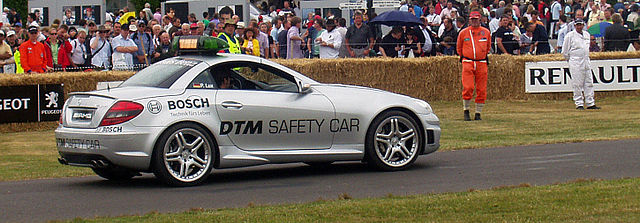In motorsport, a safety car, or a pace car, is an automobile which limits the speed of competing cars or motorcycles on a racetrack in the case of a caution period such as an obstruction on the track or bad weather. The aim of the safety car is to enable the clearance of any obstruction under safer conditions, especially for marshals and/or await more favourable track conditions weather-wise. By following the safety car, the competitors' tyres remain as close as possible to operating temperature while their engines do not overheat. A safety car is also preferred over stopping the race and restarting as the latter takes longer.
Mercedes-Benz SLK pace car of the Deutsche Tourenwagen Masters at the Goodwood Festival of Speed
Two Superleague Formula safety cars in the paddock at Silverstone Circuit
Felipe Massa driving behind a Mercedes-Benz CLK 63 AMG F1 Safety Car at the 2006 Brazilian Grand Prix. When required, the F1 safety car will lead the field around the circuit at reduced speed with the race leader immediately following.
Bernd Mayländer, the F1 safety car driver since 2000
Racing flags are traditionally used in auto racing and similar motorsports to indicate track conditions and to communicate important messages to drivers. Typically, the starter, sometimes the grand marshal of a race, waves the flags atop a flag stand near the start/finish line. Track marshals are also stationed at observation posts along the race track in order to communicate both local and course-wide conditions to drivers. Alternatively, some race tracks employ lights to supplement the primary flag at the start/finish line.
The flagman displaying the chequered flag with a complete set of stockcar racing flags
A yellow flag with SC (safety car) sign is shown during the 2006 United States Grand Prix.
A Chequered flag being used at the end of the 1906 Vanderbilt Cup
Late model stock car driver celebrates with a chequered flag








